Unit 13 We're trying to save the earth! Section A(1a-2d)课件(共37张PPT,含内嵌音视频) 人教版英语九年级全册
文档属性
| 名称 | Unit 13 We're trying to save the earth! Section A(1a-2d)课件(共37张PPT,含内嵌音视频) 人教版英语九年级全册 | 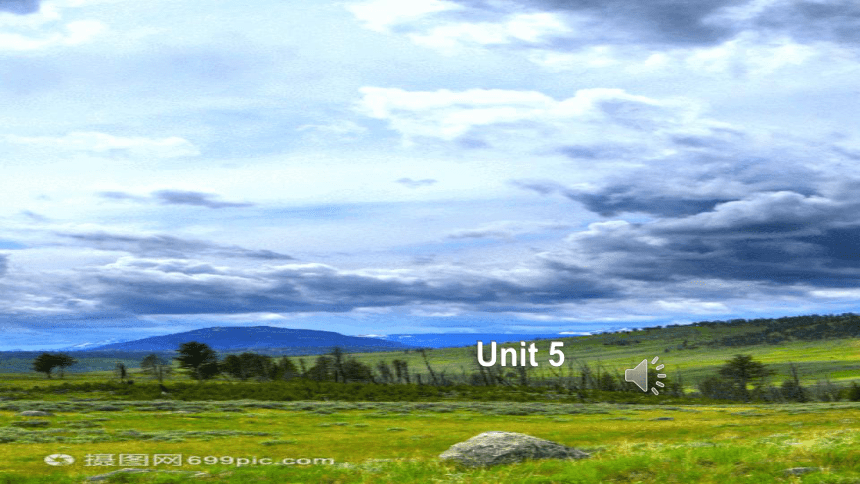 | |
| 格式 | pptx | ||
| 文件大小 | 33.5MB | ||
| 资源类型 | 教案 | ||
| 版本资源 | 人教新目标(Go for it)版 | ||
| 科目 | 英语 | ||
| 更新时间 | 2024-09-16 14:57:15 | ||
图片预览

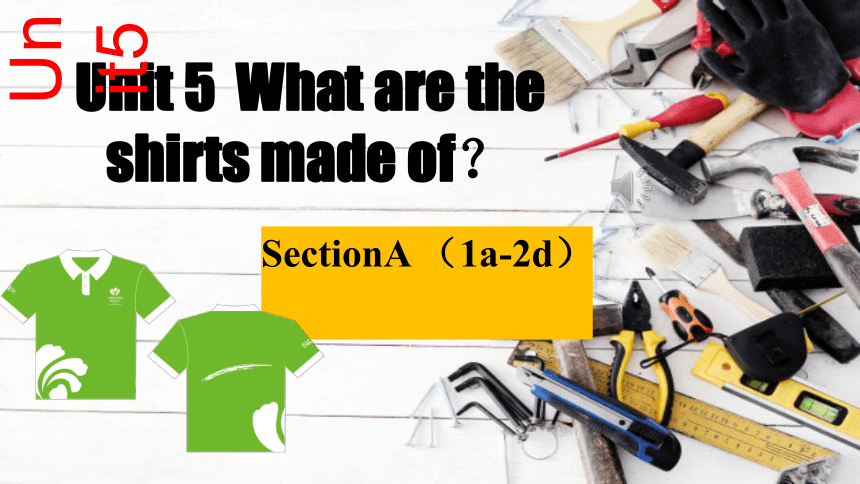
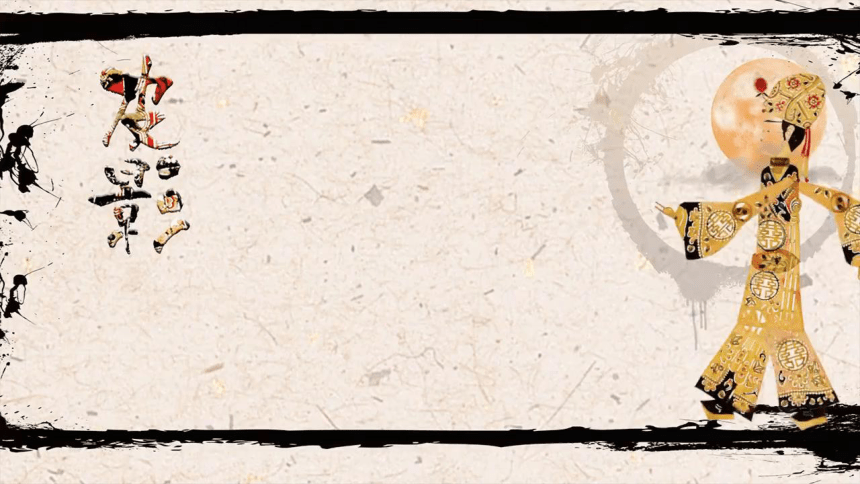

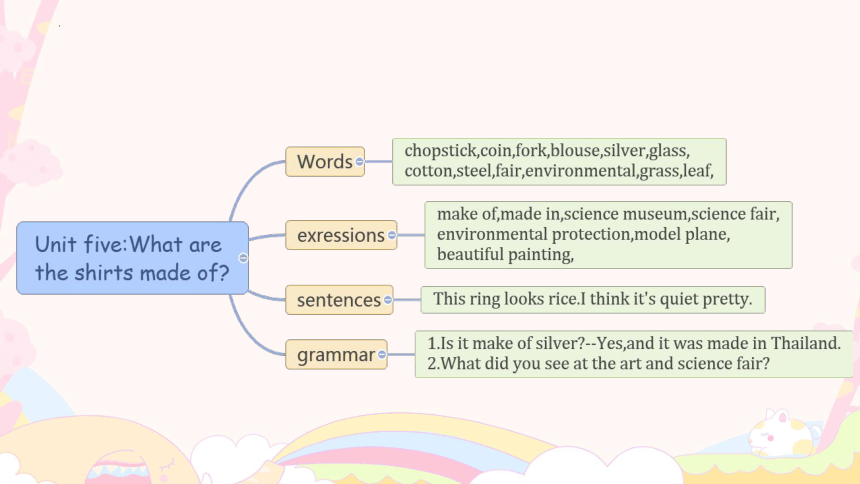
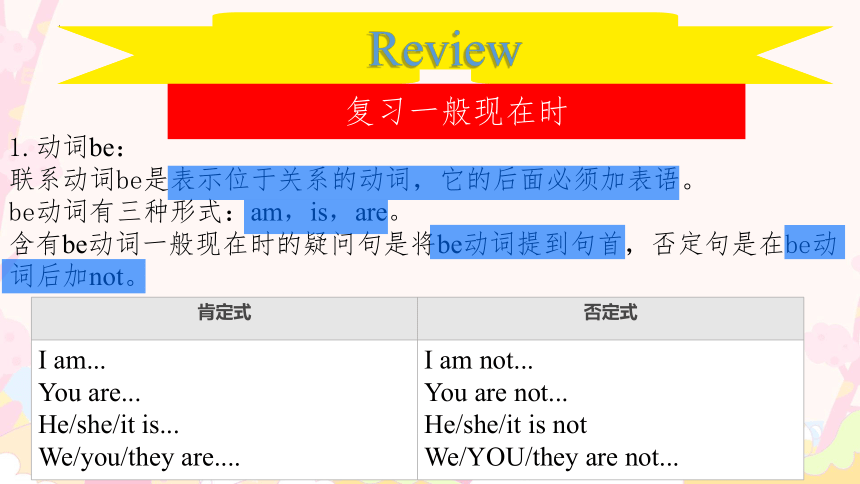
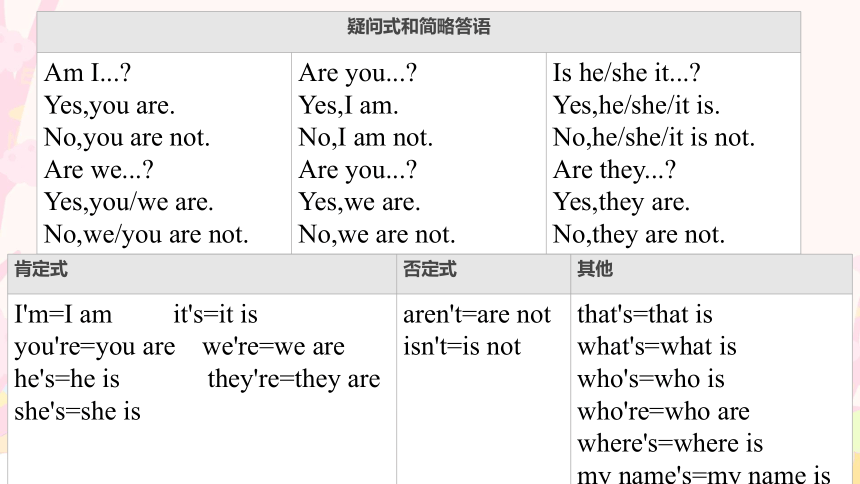
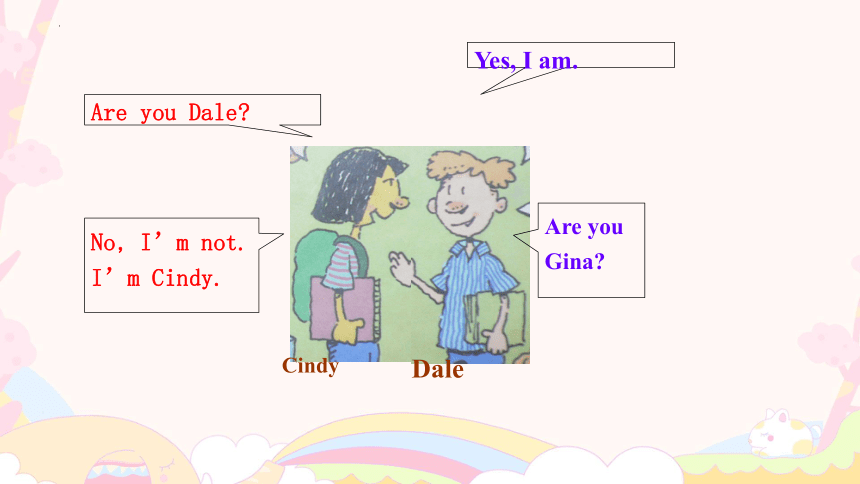
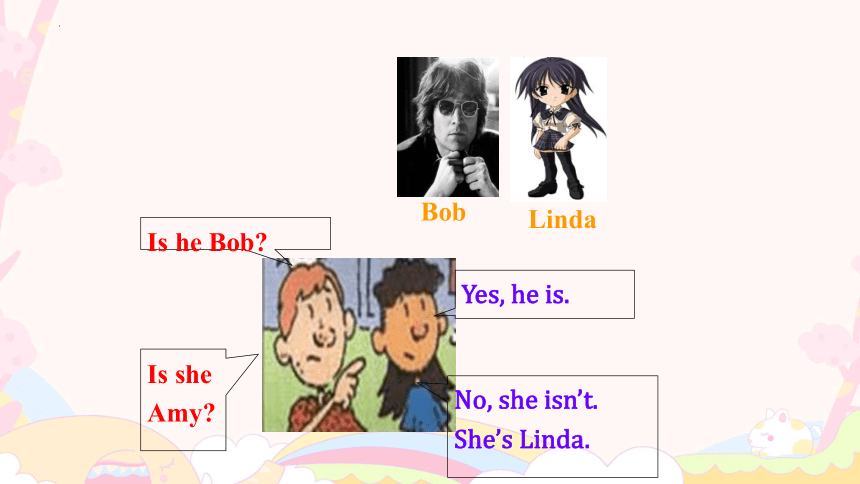
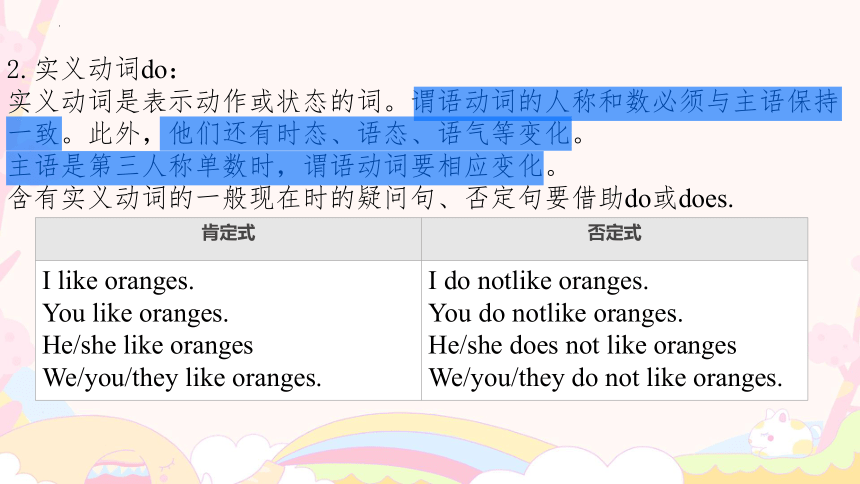
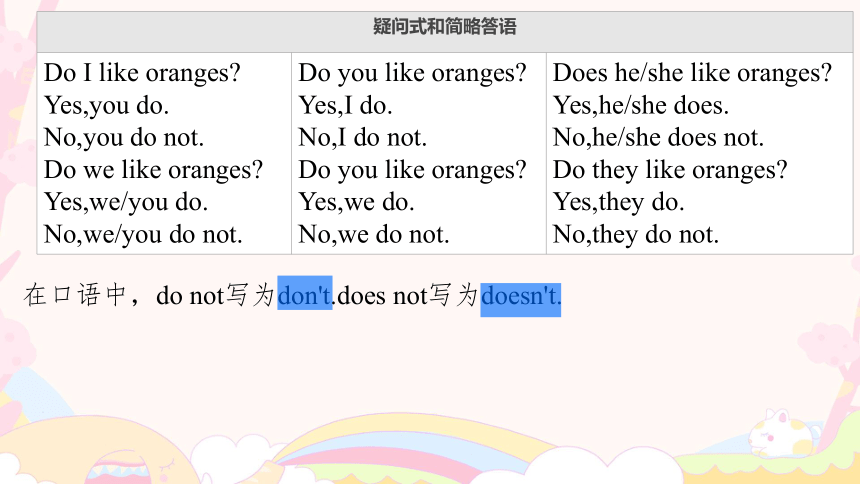
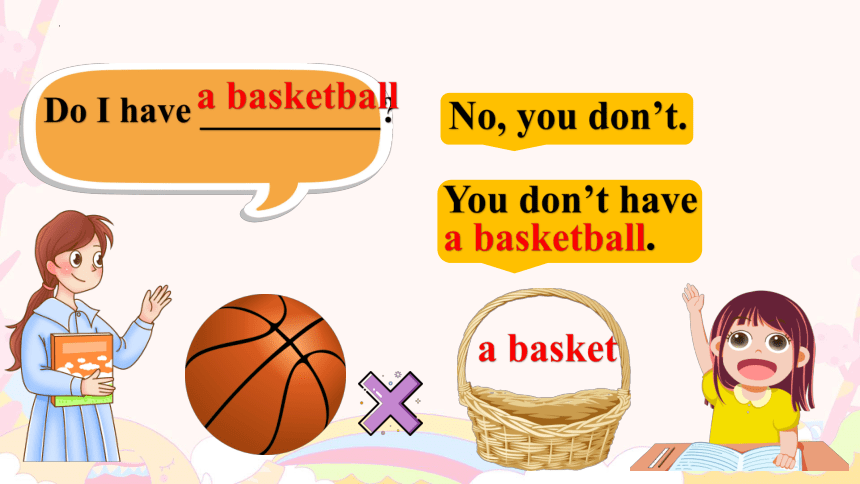
文档简介
(共37张PPT)
Unit 5
Unit 5 What are the shirts made of?
Unit5
SectionA (1a-2d)
Review
复习一般现在时
1.动词be:
联系动词be是表示位于关系的动词,它的后面必须加表语。
be动词有三种形式:am,is,are。
含有be动词一般现在时的疑问句是将be动词提到句首,否定句是在be动词后加not。
肯定式 否定式
I am... You are... He/she/it is... We/you/they are.... I am not...
You are not...
He/she/it is not
We/YOU/they are not...
疑问式和简略答语
Am I... Yes,you are. No,you are not. Are we... Yes,you/we are. No,we/you are not. Are you... Yes,I am. No,I am not. Are you... Yes,we are. No,we are not. Is he/she it...
Yes,he/she/it is.
No,he/she/it is not.
Are they...
Yes,they are.
No,they are not.
肯定式 否定式 其他
I'm=I am it's=it is you're=you are we're=we are he's=he is they're=they are she's=she is aren't=are not isn't=is not that's=that is
what's=what is
who's=who is
who're=who are
where's=where is
my name's=my name is
Cindy
Dale
Are you Dale
Yes, I am.
Are you Gina
No, I’m not.
I’m Cindy.
Is he Bob
Yes, he is.
Is she
Amy
No, she isn’t.
She’s Linda.
Bob
Linda
2.实义动词do:
实义动词是表示动作或状态的词。谓语动词的人称和数必须与主语保持一致。此外,他们还有时态、语态、语气等变化。
主语是第三人称单数时,谓语动词要相应变化。
含有实义动词的一般现在时的疑问句、否定句要借助do或does.
肯定式 否定式
I like oranges. You like oranges. He/she like oranges We/you/they like oranges. I do notlike oranges.
You do notlike oranges.
He/she does not like oranges
We/you/they do not like oranges.
疑问式和简略答语
Do I like oranges Yes,you do. No,you do not. Do we like oranges Yes,we/you do. No,we/you do not. Do you like oranges Yes,I do. No,I do not. Do you like oranges Yes,we do. No,we do not. Does he/she like oranges
Yes,he/she does.
No,he/she does not.
Do they like oranges
Yes,they do.
No,they do not.
在口语中,do not写为don't.does not写为doesn't.
No, you don’t.
You don’t have
a basketball.
Do I have __________
a basket
a basketball
I have a soccer ball.
Do you have ____________
Yes, I do.
a soccer ball
She has a baseball.
She also has
_____________.
Does she have
__________
Yes, she does.
a baseball
a baseball bat
He has a ping-pong ball and a ____________.
Does he have
__________
Yes, he does.
a ping-pong ball
ping-pong bat
They have a volleyball.
Do they have
__________
Yes, they do.
a volleyball
Do you like oranges
Yes, I do. / No, I don't.
Does he like apples
Yes, he does. /No, he doesn't.
Does she like bananas
Yes, she does. /No, she doesn't.
Do they like pears
Yes, they do. /No, they don't.
Lend in
我们认识了主动语态,那被动语态它怎么样呢?
1.概述
语态常用来说名句中主语和谓语动词的具体关系,分为主动语态和被动语态。如果主语是动作的执行者,使用主动语态。如果主语时动作的承受者,则使用被动语态。
2.构成
“be动词+及物动词的过去分词”构成。人、数和时态的变化通过be动词的变化表现出来。
3.一般现在时的被动语态
肯定句式:主语+am/is/are+及物动词的过去分词(+by短语)
否定句式:主语+am/is/are not+及物动词的过去分词(+by短语)
一般疑问句式:Am/Is/Are+主语+及物动词的过去分词(+by短语)?
特殊疑问句式:特殊疑问词+am/is/are (+主语)+及物动词的过去分词(+by短语)?
The book was written by her.
She is not invented to the party.
Is his homework finished
Where is the tea grown
被动语态的结构:
被动语态由“be+及物动词的过去分词”构成,
be有人称、数的变化。
如: The desk is made of wood.
The desks are made of wood.
He is asked a question by the teacher.
I was given a nice present by my friend yesterday.
4.如何将主动语态转化为被动语态?
Cindy beats her younger brother Paul.
The younger brother Paul is beaten by Cindy.
The monkey makes a birthday cake.
A birthday cake is made by the monkey.
Soccer is played by him every day.
2.He plays soccer every day.
English is spoken by me.
1.I speak English.
观察两组句子,他们的主语、谓语、宾语有什么特点?
主动语态
被动语态
主动语态
被动语态
1.将主动语态的宾语改为主动语态的主语
2.将主动语态的谓语改为“be+及物动词的过去分词”结构。
3.将主动语态的主语改为介词by的宾语,放在谓语之后
We speak English.
主语
谓语
宾语
English is spoken by us.
主语
谓语
宾语
主动语态
被动语态
仔细观察
主动语态 被动语态
宾语 →
谓语 →
主语 →
其他 → 抄下来
主语
be+ P.P(过去分词)
by +宾语
let’s have a try
1. He wrote an article last week.
2.The people make history.
3.We took many photos.
4.Miss Deng teaches us English.
An article was written by him last week.
History is made by the people.
Many photos are taken by us.
Our English is taught by Miss Deng.
let’s have a try
They play football on Sunday.
Lucy does the homework in the evening.
They often help him with homework.
We make these machines in Beijing.
Football is played by them on Sunday.
The homework is done by Lucy in the evening.
He is often helped by them with homework.
These mooncakes are made by us in Beijing.
5.被动语态的应用场景:
(1)不知道或没有必要说明动作的执行者时。
These books are written for children.
(2)强调动作的承受者时。
The new teacher is respected by students.
(3)在“It's said”等固定句型中。
It is said there are wolves in the forest.
(4)当动作强调动作的承受者时。此时动作的执行者由by引导置于谓语动词之后,不需要时可以省略。
The tiger was killed by him.
(5)当动作的执行者不是人时,多用被动语态。
把下列句子变为被动语态。
1. They should do it at once.
_____________________________________________________________________
2. We built the bridge last year.
____________________________________________________________________
3. She has found her lost handbags.
_____________________________________________________________________
4. She is write a letter now.
_____________________________________________________________________
5. My uncle was reading books when I came in.
_____________________________________________________________________
6. People speak English in many countries.
_____________________________________________________________________
7. Men often talk about clothes and foods.
_____________________________________________________________________
It should be done at once._____
The bridge was built by us last year.__
Her lost handbags have been found.__
The letter was written by her_._
Books were reading when I came in.____
English is spoken in many countries .
Clothes and foods are often talked about
用括号中动词的适当形式填空。
1. Some presents ____________ (buy) by my sister for me every birthday.
2. The treasure box ____________ (hide) somewhere in the city 100 years ago.
3. When she did some shopping, her money ____________ (steal).
4. Li Ming ____________ (ask) to attend the meeting yesterday.
5. There was a sandstorm yesterday and the ground ____________ (cover) by thick snow.
6. I will go with you when my homework ____________ (finish).
7. More than 1,000 English words ____________________ (learn) in the past three years.
8. All these books and clothes ____________________ (give) away to the children next week.
are bought__
was hidden
was stolen
was asked
was covered
is finished
were learnt_
will be given
被动语态的几种特殊类型
1.带双宾语句子的被动语态.指物的宾语叫直接宾语,指人的宾语叫间接宾语
give me a book = give a book to me 间宾 直宾 直宾 间宾
(1) He gave me a book. 主动语态
变为被动语态----
I was given a book by him.
(2) I bought him a book. 主动语态
变为被动语态----
He bought a book for me.
to:
for:
pass, give, show, bring, sell, send, tell, teach, return, lend...
make, buy, cook...
2.含有短语的主动语态变被动语态
They take good care of my child.
-----
My child is taken good care of .
I turned off the radio.
-----
The radio was turned off (by me).
动词短语是一个不可分割的整体,在变为被动语态时,不可丢掉构成的动词短语的介词和副词。
3.感官动词和使役动词的被动语态
即:三眼:see watch look at(notice)
两耳:hear listen to
一感觉:feel
三使役:make have let
e.g. 1.I saw him play basketball last Sunday.
---
2.The boss makes him work for 10 hours.
---
He was seen to play basketball last Sunday.
He is made to work for 10 hours.
这些词在主动句中,其后的动词不加to,但变被动句时必须加to.
不用被动语态的情况
1)像happen, take place,等不及物动词没有被动语态。
e.g. A traffic accident happened just now.
2)连系动词look, sound, taste, smell,feel 等不用被动语态。
e.g. Mooncakes taste delicious.
The idea sounds great.
难点:主动形式表被动意义
1)当表示主语质地,自身特征的动词open, lock, write, read, sell, clean, wash, cut, burn, drive 与副词well或easily连用时,可用主动语态表被动意义,用作不及物动词。
This kind of pen writes smoothly.
This kind of shirt sells well here.
2) 在be worth doing中,doing表被动意义
he book is worth reading.
3) need doing =need to be done . to be done 表不定式的被动结构。
My bike needs repairing.= My bike needs to be repaired.
1. I sing the song.
The song_________by me.
2. You play the song.
The song ______________.
3. He plays the drums.
The drums_____________.
4. She sings the song.
The song is sung________.
is sung
is played by you
are played by him
by her
paper
compass
gunpowder
printing technique
The four great inventions
1. Who invented paper first
Cai Lun invented it in the Han Dynasty.
2. What was paper made of then
It was mainly made of bamboo.
3. Was it easy for people to make paper then
No, it wasn’t. It was very difficult.
4. What’s paper made of today
It is mainly made of wood, bamboo and cotton.
Unit 5
Unit 5 What are the shirts made of?
Unit5
SectionA (1a-2d)
Review
复习一般现在时
1.动词be:
联系动词be是表示位于关系的动词,它的后面必须加表语。
be动词有三种形式:am,is,are。
含有be动词一般现在时的疑问句是将be动词提到句首,否定句是在be动词后加not。
肯定式 否定式
I am... You are... He/she/it is... We/you/they are.... I am not...
You are not...
He/she/it is not
We/YOU/they are not...
疑问式和简略答语
Am I... Yes,you are. No,you are not. Are we... Yes,you/we are. No,we/you are not. Are you... Yes,I am. No,I am not. Are you... Yes,we are. No,we are not. Is he/she it...
Yes,he/she/it is.
No,he/she/it is not.
Are they...
Yes,they are.
No,they are not.
肯定式 否定式 其他
I'm=I am it's=it is you're=you are we're=we are he's=he is they're=they are she's=she is aren't=are not isn't=is not that's=that is
what's=what is
who's=who is
who're=who are
where's=where is
my name's=my name is
Cindy
Dale
Are you Dale
Yes, I am.
Are you Gina
No, I’m not.
I’m Cindy.
Is he Bob
Yes, he is.
Is she
Amy
No, she isn’t.
She’s Linda.
Bob
Linda
2.实义动词do:
实义动词是表示动作或状态的词。谓语动词的人称和数必须与主语保持一致。此外,他们还有时态、语态、语气等变化。
主语是第三人称单数时,谓语动词要相应变化。
含有实义动词的一般现在时的疑问句、否定句要借助do或does.
肯定式 否定式
I like oranges. You like oranges. He/she like oranges We/you/they like oranges. I do notlike oranges.
You do notlike oranges.
He/she does not like oranges
We/you/they do not like oranges.
疑问式和简略答语
Do I like oranges Yes,you do. No,you do not. Do we like oranges Yes,we/you do. No,we/you do not. Do you like oranges Yes,I do. No,I do not. Do you like oranges Yes,we do. No,we do not. Does he/she like oranges
Yes,he/she does.
No,he/she does not.
Do they like oranges
Yes,they do.
No,they do not.
在口语中,do not写为don't.does not写为doesn't.
No, you don’t.
You don’t have
a basketball.
Do I have __________
a basket
a basketball
I have a soccer ball.
Do you have ____________
Yes, I do.
a soccer ball
She has a baseball.
She also has
_____________.
Does she have
__________
Yes, she does.
a baseball
a baseball bat
He has a ping-pong ball and a ____________.
Does he have
__________
Yes, he does.
a ping-pong ball
ping-pong bat
They have a volleyball.
Do they have
__________
Yes, they do.
a volleyball
Do you like oranges
Yes, I do. / No, I don't.
Does he like apples
Yes, he does. /No, he doesn't.
Does she like bananas
Yes, she does. /No, she doesn't.
Do they like pears
Yes, they do. /No, they don't.
Lend in
我们认识了主动语态,那被动语态它怎么样呢?
1.概述
语态常用来说名句中主语和谓语动词的具体关系,分为主动语态和被动语态。如果主语是动作的执行者,使用主动语态。如果主语时动作的承受者,则使用被动语态。
2.构成
“be动词+及物动词的过去分词”构成。人、数和时态的变化通过be动词的变化表现出来。
3.一般现在时的被动语态
肯定句式:主语+am/is/are+及物动词的过去分词(+by短语)
否定句式:主语+am/is/are not+及物动词的过去分词(+by短语)
一般疑问句式:Am/Is/Are+主语+及物动词的过去分词(+by短语)?
特殊疑问句式:特殊疑问词+am/is/are (+主语)+及物动词的过去分词(+by短语)?
The book was written by her.
She is not invented to the party.
Is his homework finished
Where is the tea grown
被动语态的结构:
被动语态由“be+及物动词的过去分词”构成,
be有人称、数的变化。
如: The desk is made of wood.
The desks are made of wood.
He is asked a question by the teacher.
I was given a nice present by my friend yesterday.
4.如何将主动语态转化为被动语态?
Cindy beats her younger brother Paul.
The younger brother Paul is beaten by Cindy.
The monkey makes a birthday cake.
A birthday cake is made by the monkey.
Soccer is played by him every day.
2.He plays soccer every day.
English is spoken by me.
1.I speak English.
观察两组句子,他们的主语、谓语、宾语有什么特点?
主动语态
被动语态
主动语态
被动语态
1.将主动语态的宾语改为主动语态的主语
2.将主动语态的谓语改为“be+及物动词的过去分词”结构。
3.将主动语态的主语改为介词by的宾语,放在谓语之后
We speak English.
主语
谓语
宾语
English is spoken by us.
主语
谓语
宾语
主动语态
被动语态
仔细观察
主动语态 被动语态
宾语 →
谓语 →
主语 →
其他 → 抄下来
主语
be+ P.P(过去分词)
by +宾语
let’s have a try
1. He wrote an article last week.
2.The people make history.
3.We took many photos.
4.Miss Deng teaches us English.
An article was written by him last week.
History is made by the people.
Many photos are taken by us.
Our English is taught by Miss Deng.
let’s have a try
They play football on Sunday.
Lucy does the homework in the evening.
They often help him with homework.
We make these machines in Beijing.
Football is played by them on Sunday.
The homework is done by Lucy in the evening.
He is often helped by them with homework.
These mooncakes are made by us in Beijing.
5.被动语态的应用场景:
(1)不知道或没有必要说明动作的执行者时。
These books are written for children.
(2)强调动作的承受者时。
The new teacher is respected by students.
(3)在“It's said”等固定句型中。
It is said there are wolves in the forest.
(4)当动作强调动作的承受者时。此时动作的执行者由by引导置于谓语动词之后,不需要时可以省略。
The tiger was killed by him.
(5)当动作的执行者不是人时,多用被动语态。
把下列句子变为被动语态。
1. They should do it at once.
_____________________________________________________________________
2. We built the bridge last year.
____________________________________________________________________
3. She has found her lost handbags.
_____________________________________________________________________
4. She is write a letter now.
_____________________________________________________________________
5. My uncle was reading books when I came in.
_____________________________________________________________________
6. People speak English in many countries.
_____________________________________________________________________
7. Men often talk about clothes and foods.
_____________________________________________________________________
It should be done at once._____
The bridge was built by us last year.__
Her lost handbags have been found.__
The letter was written by her_._
Books were reading when I came in.____
English is spoken in many countries .
Clothes and foods are often talked about
用括号中动词的适当形式填空。
1. Some presents ____________ (buy) by my sister for me every birthday.
2. The treasure box ____________ (hide) somewhere in the city 100 years ago.
3. When she did some shopping, her money ____________ (steal).
4. Li Ming ____________ (ask) to attend the meeting yesterday.
5. There was a sandstorm yesterday and the ground ____________ (cover) by thick snow.
6. I will go with you when my homework ____________ (finish).
7. More than 1,000 English words ____________________ (learn) in the past three years.
8. All these books and clothes ____________________ (give) away to the children next week.
are bought__
was hidden
was stolen
was asked
was covered
is finished
were learnt_
will be given
被动语态的几种特殊类型
1.带双宾语句子的被动语态.指物的宾语叫直接宾语,指人的宾语叫间接宾语
give me a book = give a book to me 间宾 直宾 直宾 间宾
(1) He gave me a book. 主动语态
变为被动语态----
I was given a book by him.
(2) I bought him a book. 主动语态
变为被动语态----
He bought a book for me.
to:
for:
pass, give, show, bring, sell, send, tell, teach, return, lend...
make, buy, cook...
2.含有短语的主动语态变被动语态
They take good care of my child.
-----
My child is taken good care of .
I turned off the radio.
-----
The radio was turned off (by me).
动词短语是一个不可分割的整体,在变为被动语态时,不可丢掉构成的动词短语的介词和副词。
3.感官动词和使役动词的被动语态
即:三眼:see watch look at(notice)
两耳:hear listen to
一感觉:feel
三使役:make have let
e.g. 1.I saw him play basketball last Sunday.
---
2.The boss makes him work for 10 hours.
---
He was seen to play basketball last Sunday.
He is made to work for 10 hours.
这些词在主动句中,其后的动词不加to,但变被动句时必须加to.
不用被动语态的情况
1)像happen, take place,等不及物动词没有被动语态。
e.g. A traffic accident happened just now.
2)连系动词look, sound, taste, smell,feel 等不用被动语态。
e.g. Mooncakes taste delicious.
The idea sounds great.
难点:主动形式表被动意义
1)当表示主语质地,自身特征的动词open, lock, write, read, sell, clean, wash, cut, burn, drive 与副词well或easily连用时,可用主动语态表被动意义,用作不及物动词。
This kind of pen writes smoothly.
This kind of shirt sells well here.
2) 在be worth doing中,doing表被动意义
he book is worth reading.
3) need doing =need to be done . to be done 表不定式的被动结构。
My bike needs repairing.= My bike needs to be repaired.
1. I sing the song.
The song_________by me.
2. You play the song.
The song ______________.
3. He plays the drums.
The drums_____________.
4. She sings the song.
The song is sung________.
is sung
is played by you
are played by him
by her
paper
compass
gunpowder
printing technique
The four great inventions
1. Who invented paper first
Cai Lun invented it in the Han Dynasty.
2. What was paper made of then
It was mainly made of bamboo.
3. Was it easy for people to make paper then
No, it wasn’t. It was very difficult.
4. What’s paper made of today
It is mainly made of wood, bamboo and cotton.
同课章节目录
- Unit 1 How can we become good learners.
- Section A
- Section B
- Unit 2 I think that mooncakes are delicious!
- Section A
- Section B
- Unit 3 Could you please tell me where the restroom
- Section A
- Section B
- Unit 4 I used to be afraid of the dark.
- Section A
- Section B
- Unit 5 What are the shirts made of?
- Section A
- Section B
- Review of Units 1-5
- Unit 6 When was it invented?
- Section A
- Section B
- Unit 7 Teenagers should be allowed to choose their
- Section A
- Section B
- Unit 8 It must belong to Carla.
- Section A
- Section B
- Unit 9 I like music that I can dance to.
- Section A
- Section B
- Unit 10 You're supposed to shake hands.
- Section A
- Section B
- Review of Units 6-10
- Unit 11 Sad movies make me cry.
- Section A
- Section B
- Unit 12 Life is full of the unexpected
- Section A
- Section B
- Unit 13 We're trying to save the earth!
- Section A
- Section B
- Unit 14 I remember meeting all of you in Grade 7.
- Section A
- Section B
- Review of Units 11-14
